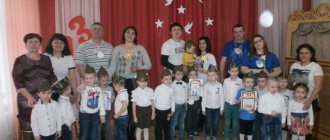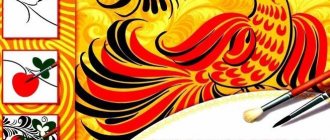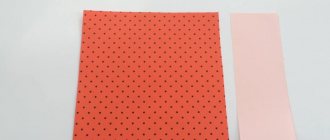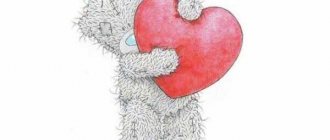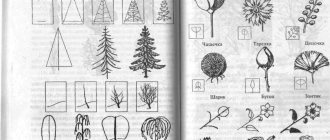Summary of GCD in the senior group. Decorative drawing
Abstract of educational activities in the senior group on the topic “Decorative drawing based on Dymkovo painting”
Author: Nadezhda Fidarisovna Sabiryanova, teacher of MBDOU “Kindergarten No. 5 “Alenushka” in the village of Shushnur” Description of the material : I offer you a summary of direct educational activities for children of the senior group on the topic “Decorative drawing based on Dymkovo painting.”
This material will be useful to teachers of the senior group. This is a summary of an educational lesson aimed at strengthening the skills of drawing elements of Dymkovo painting. Summary of direct educational activities in the senior group on the topic “Decorative drawing based on Dymkovo painting”
Integration of educational areas: “Cognition”, “Communication”, “Socialization”, “artistic and aesthetic development”. Goal: Continue to form an idea of Dymkovo painting. Objectives: Educational:
To teach techniques for drawing smooth lines when working with a brush and the ability to draw with the tip of a brush.
Strengthen the skills of drawing elements of Dymkovo painting (circles, dots, stripes, grid, ring, arcs, wavy lines). Developmental:
Develop a sense of rhythm.
Educational:
To cultivate respect for the work of folk craftsmen.
Material for children: patterns, template of the Dymkovo lady, exhibition of toys. GCD progress Educator: Hello guys. Today we will visit the exhibition. Look how beautiful it is here. How many toys? Let's look at them. How bright, beautiful and very different they are, but they have something in common. Educator: Now listen to the legend: Far, far away behind the dense forests behind the long fields on the banks of the blue river there was a large village. Every morning people got up and lit the stoves. And blue smoke hung from the chimneys of the houses. There was a lot of smoke in the village. So they nicknamed the village Dymkovo. There lived cheerful and mischievous people in that village. They loved to sculpt funny, bright, simple toys and whistles. They will make a lot of them for the long winter. When the cheerful sun runs away from the fields, cheerful people take out their cheerful toys and whistle spring, drive away winter. Funny toys were sold in different cities and villages. And therefore, toys from the village began to be called Dymkovo toys. Educator: Guys, think and tell me what these toys are called? Children: Dymkovsky. Educator: What color are Dymkovo toys? Children: Always white. Educator: What patterns are applied to toys? Children: Straight lines, wavy, dot, circle. Educator: What color are the patterns of Dymkovo toys? Children: blue, yellow, red, black. Educator: What techniques are used to make the patterns? Children: Dip flat on the pile. Educator: Today we will paint a dress from Dymkovo. Now I will tell you how we should decorate the dress of the young lady of the village of Dymkovo. Educator: But first, let's remember how to hold the brush correctly when working. Children: The hand is located between the thumb and middle finger, the index finger is held on top. Educator: Correct. Look how I hold my brush. You should hold the brush the same way. Educator: So, let's take a template. If you want to decorate a dress with dots, hold the brush vertically; if you want to decorate it with stripes, you need to hold the brush obliquely, moving it along the pile from left to right. Choose your own patterns and colors. Sit comfortably. Let's start decorating the dress. (During the lesson, the teacher comes up and provides assistance). Physical exercise: A bird, a bird flew in and sat down on a tree. It flaps its wings and dances quietly. Educator: Now finish your work, finish drawing the patterns, and then we’ll look at the drawings. Educator: Guys, how did we work today? Children: Okay. Educator: What did you like? Educator: Did you like the way you drew? Children: Yes. Educator: What new have you learned? Educator: Well done, everyone tried to create new beautiful Dymkovo patterns. The lesson is over.
We recommend watching:
Summary of GCD in the senior group on the topic: “Expedition to the taiga”
Synopsis of an integrated GCD in the senior group “Chest of Health” Synopsis of GCD in the senior group “Journey to a Fairy Tale”
Intellectual quiz “What? Where? When?" in the senior group
Similar articles:
Summary of GCD for the senior group of kindergarten
Cognitive lesson in the senior group
Summary of GCD in the senior group. Excursion into nature
Summary of educational activities on cognitive development with elements of experimentation in the senior group
Abstract of GCD in the senior group on the topic: “Mathematics - Logic”
LESSON SUMMARY ON DECORATIVE DRAWING “THE MIRACLE OF GZHEL”
Transcript
1 Mikhailova Marina Borisovna State budgetary special (correctional) educational institution for students with disabilities special (correctional) secondary school 657 Primorsky district of St. Petersburg LESSON SUMMARY ON DECORATIVE DRAWING “THE MIRACLE OF GZHEL” Goal: to expand children’s knowledge about Gzhel painting Objectives : teach children to independently decorate the silhouettes of dishes (cups, saucers) with characteristic elements of Gzhel painting; — consolidate drawing skills with the whole brush and its end; — consolidate the ability to evenly alternate flowers, leaves and berries in a circle; - exercise children in identifying cold and warm colors of the spectrum; develop memory, attention, speech; — replenish students’ active and passive vocabulary. to cultivate interest in folk art, respect for the work of folk craftsmen, patriotic pride in Russia, rich in folk talents. Equipment: Gzhel dishes, tables with painted elements, sample cup and saucer. Silhouette images of a cup and saucer. Cut pictures. Chamomile petals with warm and cold tones, wreath with ribbons. Progress of the lesson:
2 Organizational moment: An exhibition of Gzhel ceramics was organized in the classroom. The teacher is dressed in folk costume. Children enter the classroom to the tune of a Russian melody. The teacher calls everyone together: “Hey, honest gentlemen! Come join us here! How do we have containers, bars, all sorts of different goods. Come, come, Look, look!” Children come up and look at the Gzhel ceramics: “Look what a wonderful painting on this dish.” Sit down. Now I will tell you about Gzhel folk craft. — “In a certain kingdom, a Russian state, not far from Moscow, among forests and fields, stands the town of Gzhel. A long time ago, there lived cheerful and beautiful, brave and skillful craftsmen. They got together one day and began to think about how it would be better for them to show their skills, please all the people, and glorify their land. We thought, thought and came up with something. They found wonderful, white clay in their native land. And they decided to sculpt various dishes from it, and such as the world had never seen. They painted their dishes with blue paint of different shades. Painted on dishes
3 different patterns of mesh, stripes and flowers. The dishes turned out to be very intricate and elegant. People fell in love with her and the world began to call her “a gentle blue miracle.” The masters glorified their beloved land throughout the world and told everyone what skilled craftsmen live in Rus'. Children read poems: “Blue birds across a white sky, A sea of blue flowers. Jugs and mugs true or false? Golden handicrafts." “The blue fairy tale is a feast for the eyes, Like drops in the spring. Affection, care, warmth and patience Russian ringing Gzhel
4 — What products did the craftsmen sculpt? — How did they decorate their dishes? — What colors did you use in your work? — What is the name of this painting? (Children answer questions) 1. Now you and I will play. The first game is “Collect the broken dishes.” From individual parts, children assemble a complete product: a saucer and a cup. 2. The second game “Who can collect the daisy faster.” The daisies must be the same color: either cold shades or warm ones. You completed the tasks well. But there is time for business, and time for fun. So we'll work now. (Children sit at the tables) - Gzhel masters worked hard and well, it’s not for nothing that the people composed many proverbs and sayings about work. Let's remember some of them. - You can't pull a fish out of a pond without difficulty. - Like the master, so is the work. - What goes around comes around. - Labor feeds a person, but laziness spoils him. - Persistence and work will grind everything down. — Now we will paint the silhouette of a cup and saucer. CUP. — where is the pattern on the cup? (in the center, in the middle) - what colors are used? (blue, cyan) - What needs to be done to get a dark blue color? (you need to press the brush harder) - What needs to be done to make the shade lighter? (press the brush less).
5 — Where do we paint it completely with blue paint? (along the edge of the cup, bottom and handle) - Where do we start painting the pattern? (from large parts, petals, core, stem, leaves). — What do they paint next? (edge of cup, bottom, then handle) SAUCER. — We are looking at a sample saucer. -Where is the big flower located? (in the middle) - What do we highlight with a straight line? (bottom of the saucer) - How is the pattern located? (in a circle) - What does the pattern consist of? (alternating flowers, leaves and berries) - What wild berries are used in the pattern? (blueberry, blueberry) - To draw blueberries, what do you need to do? (you need to press the brush hard) - And to draw blueberries? (press weaker) - We will decorate the edge of the saucer with a border. This will give the saucer a finished look. The border should be painted holding the brush flat. — What is the procedure for painting? (from the middle to the edge). The teacher removes the samples and leaves only tables with elements of Gzhel painting. Children begin to work independently. The teacher conducts individual work with children. 6.Analysis of work: Mark the children who: have a correctly drawn pattern, correctly chosen colors, a cup and saucer that look like real Gzhel ones. - Finished the job, go for a walk! We worked hard, and now we can play.
6 Game "Carousel". For the game, a wreath with long ribbons according to the number of students is used. The game is played to a Russian melody with the words: “Barely, barely, barely, the carousel began to spin. And then, then, then, still running, running, running. Hush hush, don't run. Stop the carousel. One, two. One, two, the game is over.” Summary of the lesson. It's time to part ways. You worked hard, your painting turned out well, almost like the real masters of Gzhel. Well done! The lesson is over.
Tasks, techniques and features of decorative drawing in the preparatory group
Decorative drawing - creating abstract rhythmic patterns and compositions to decorate objects. Drawing ornaments has a beneficial effect on the development of creativity, fine motor skills, imagination and fantasy, abstract and spatial thinking, sensory perception and the child’s intellectual abilities for synthesis and analysis.
Tasks
- develop a sense of color, learn to find an interesting and harmonious combination of colors;
- consolidate the ability to draw according to a model, teach drawing patterns based on a free design;
- improve technical skills in using a pencil and brush: draw dots, curls, wavy, straight, rounded lines with the tip and entire surface of the brush;
- freely change the direction of brush movement;
- be able to adjust the paint set and mix different colors to obtain the desired shade
Techniques
- A line can be straight, broken, wavy, twisted into a spiral, can be of different lengths, thicknesses and rhythms and helps create the basis for a pattern and draw decorative elements.
- Hatching with colored pencils is a simple, but expressive and effective way to convey the rhythmic image of a floral or geometric pattern. In addition, drawing with strokes helps develop fine motor skills, which is very important for solving the problem of preparing the hand for writing.
- Shading - helps to achieve different degrees of color saturation depending on the degree of pressure of the pencil. It should be explained to children that drawing the pattern grid and decorative elements requires more pressure than painting the background.
- A point with the tip of the brush, a rhythmic stroke, brushing the entire surface with the brush.
Peculiarities
- The main material for painting is gouache, since its overlapping ability allows you to apply a drawing to a tinted background surface. Drawing techniques with watercolors, wax crayons and felt-tip pens are also used, in addition, combined and non-traditional ones, for example, finger painting, salt painting, monotype, scratching, nitkografiya.
The works were performed using the grattage technique (scratching a pattern onto a surface primed with ink or black gouache) - Children of senior preschool age can use colored pencils in decorative drawing, since their level of mastery of shading techniques allows them to obtain an even and bright color effect. In addition, using shading techniques, children can create a pattern with one color, alternating different degrees of pencil pressure, conveying, for example, a transition from a brighter shade to a more delicate one, sketching the petals of a flower.
- In addition to previously mastered circle and square shapes, children are introduced to pattern construction on rectangular and polygonal geometric shapes, as well as on the silhouettes of various objects (jugs, cups, spoons, hats, etc.). Objects of irregular geometric shape are decorated both with a linear ornament, for example, for edging the neck, and using a pattern from the center on a round part or a pattern from a corner on a rectangular shape.
- Older preschoolers study symmetrical mirror image, when a drawing consists of two identical parts arranged in opposite ways.
- In the preparatory group, they are taught the technique of filling the entire space of a form with a so-called mesh pattern, which is built on the principle of alternating elements in a checkerboard pattern.
- To create patterns and paint toys or dishes, elements of floral patterns and folk applied art are used (curls, small grass patterns, color combinations of Dymkovo, Zhostovo, Khokhloma painting).
Children's decorative painting works (photo gallery)
Subject composition in the style of the Dymkovo tradition
Decoration of the product with floral patterns (rowan branch) Golden Khokhloma
Painting with decorative elements (berries, curls, stripes, dots)
Painting with floral patterns (strawberries, grass, leaves)
Fiery colors of Khokhloma (berries, curls, grass)
Drawing curls and grass on a tall product
Decorative painting with floral patterns
